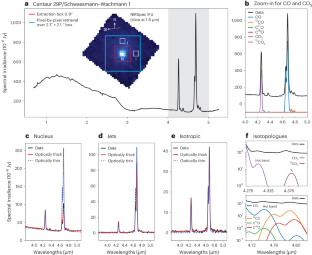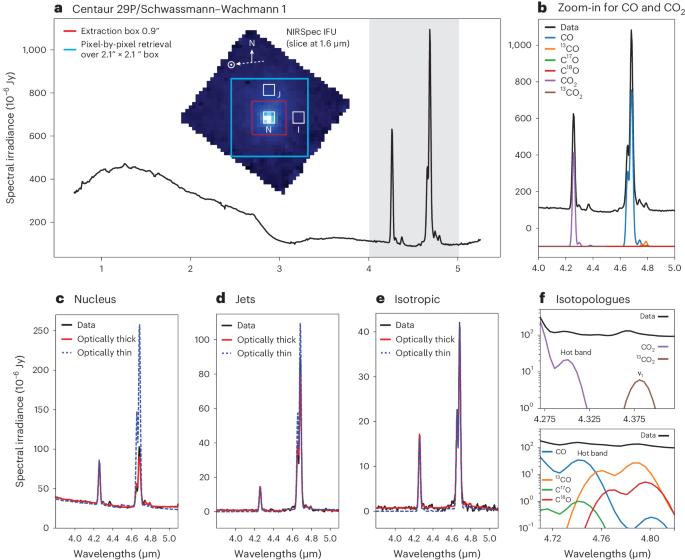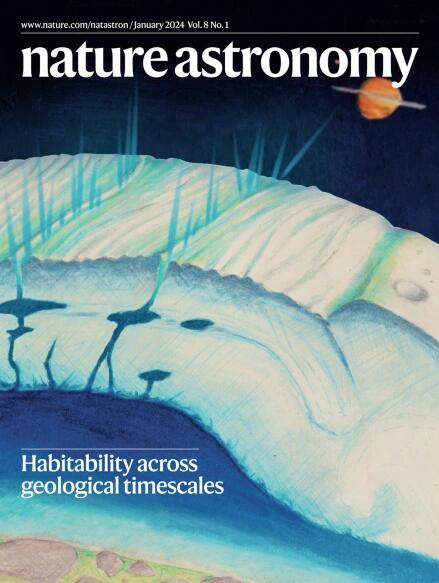在活动半人马座 29P/Schwassmann-Wachmann 1 上发现的异质排气区域
IF 14.3
1区 物理与天体物理
Q1 ASTRONOMY & ASTROPHYSICS
引用次数: 0
摘要
半人马是介于原始海王星天体和木星眷属彗星之间的过渡天体。它们的组成和活动为研究这些小天体的演化过程以及它们之间的相互作用提供了基本线索。我们在此报告利用詹姆斯-韦伯太空望远镜(JWST)对半人马座 29P/Schwassmann-Wachmann 1(29P)的观测结果。我们确定了驱动排气活动的具有异质成分的局部喷流。我们利用 NIRSpec 绘图光谱仪研究了一氧化碳的荧光发射,并为该目标明确探测到了二氧化碳。该仪器的高灵敏度还使我们能够探测碳和氧的同位素特征。分子图显示了复杂的排气分布,如喷流和各向异性形态,这表明 29P 的原子核主要由具有异质成分的活跃区域组成。这些分布可能反映了它具有成分各异的双叶结构,或者在核上发生了强烈的差异侵蚀。由于目前还没有计划访问半人马的飞行任务,这些观测显示了 JWST 在描述这些天体特征方面的独特能力。本文章由计算机程序翻译,如有差异,请以英文原文为准。


Heterogeneous outgassing regions identified on active centaur 29P/Schwassmann–Wachmann 1
Centaurs are transitional objects between primitive trans-Neptunian objects and Jupiter-family comets. Their compositions and activities provide fundamental clues regarding the processes affecting the evolution of and interplay between these small bodies. Here we report observations of centaur 29P/Schwassmann–Wachmann 1 (29P) with the James Webb Space Telescope (JWST). We identified localized jets with heterogeneous compositions driving the outgassing activity. We employed the NIRSpec mapping spectrometer to study the fluorescence emissions of CO and obtain a definitive detection of CO2 for this target. The exquisite sensitivity of the instrument also enabled carbon and oxygen isotopic signatures to be probed. Molecular maps reveal complex outgassing distributions, such as jets and anisotropic morphology, which indicate that 29P’s nucleus is dominated by active regions with heterogeneous compositions. These distributions could reflect that it has a bilobate structure with compositionally distinct components or that strong differential erosion takes place on the nucleus. As there are no missions currently planning to visit a centaur, these observations demonstrate JWST’s unique capabilities in characterizing these objects. Centaur 29P/Schwassmann–Wachmann 1 exhibits a fascinating outgassing pattern in JWST observations, with compositional heterogeneities that may be related to the bilobate nature of its nucleus. The detection of CO and CO2 isotopologues is also reported.
求助全文
通过发布文献求助,成功后即可免费获取论文全文。
去求助
来源期刊

Nature Astronomy
Physics and Astronomy-Astronomy and Astrophysics
CiteScore
19.50
自引率
2.80%
发文量
252
期刊介绍:
Nature Astronomy, the oldest science, has played a significant role in the history of Nature. Throughout the years, pioneering discoveries such as the first quasar, exoplanet, and understanding of spiral nebulae have been reported in the journal. With the introduction of Nature Astronomy, the field now receives expanded coverage, welcoming research in astronomy, astrophysics, and planetary science. The primary objective is to encourage closer collaboration among researchers in these related areas.
Similar to other journals under the Nature brand, Nature Astronomy boasts a devoted team of professional editors, ensuring fairness and rigorous peer-review processes. The journal maintains high standards in copy-editing and production, ensuring timely publication and editorial independence.
In addition to original research, Nature Astronomy publishes a wide range of content, including Comments, Reviews, News and Views, Features, and Correspondence. This diverse collection covers various disciplines within astronomy and includes contributions from a diverse range of voices.
 求助内容:
求助内容: 应助结果提醒方式:
应助结果提醒方式:


